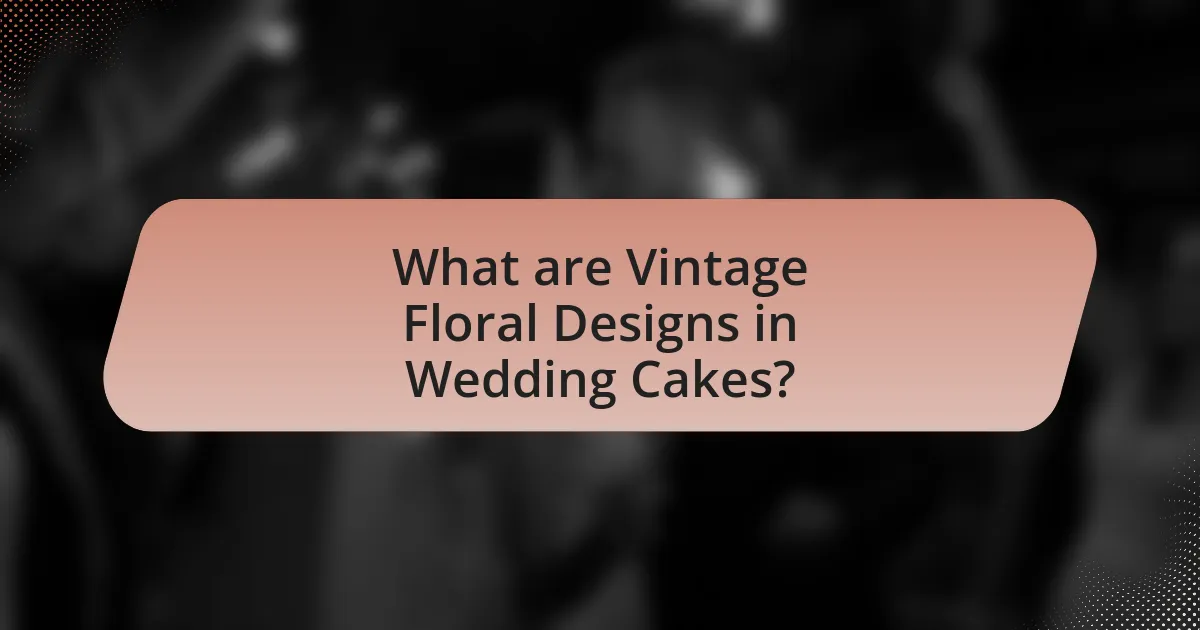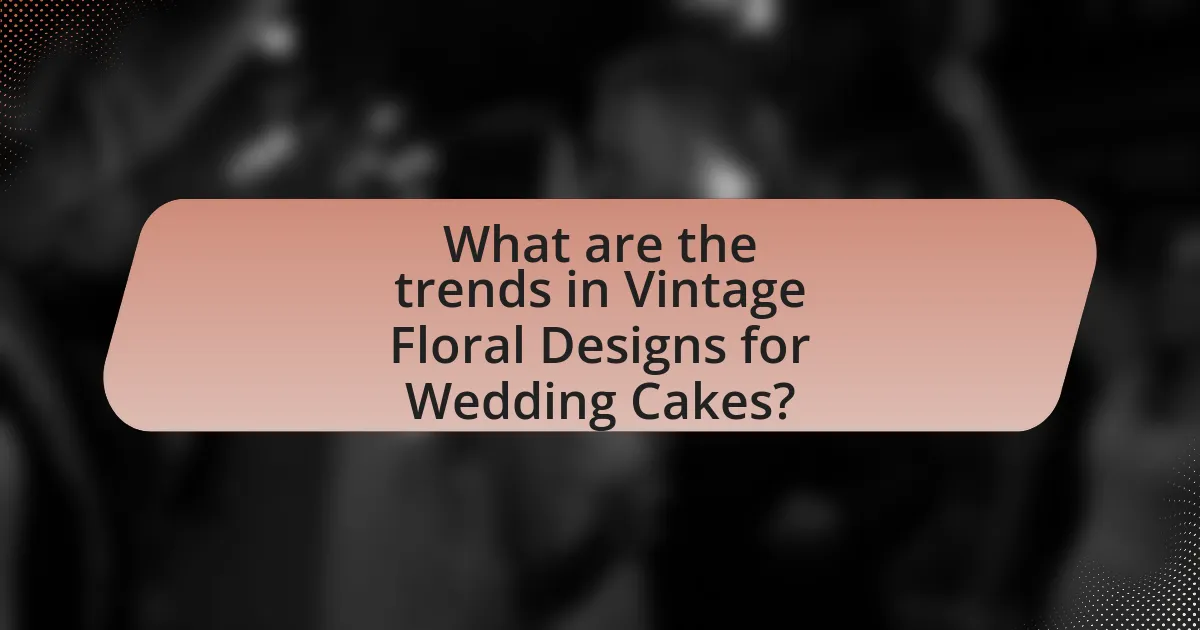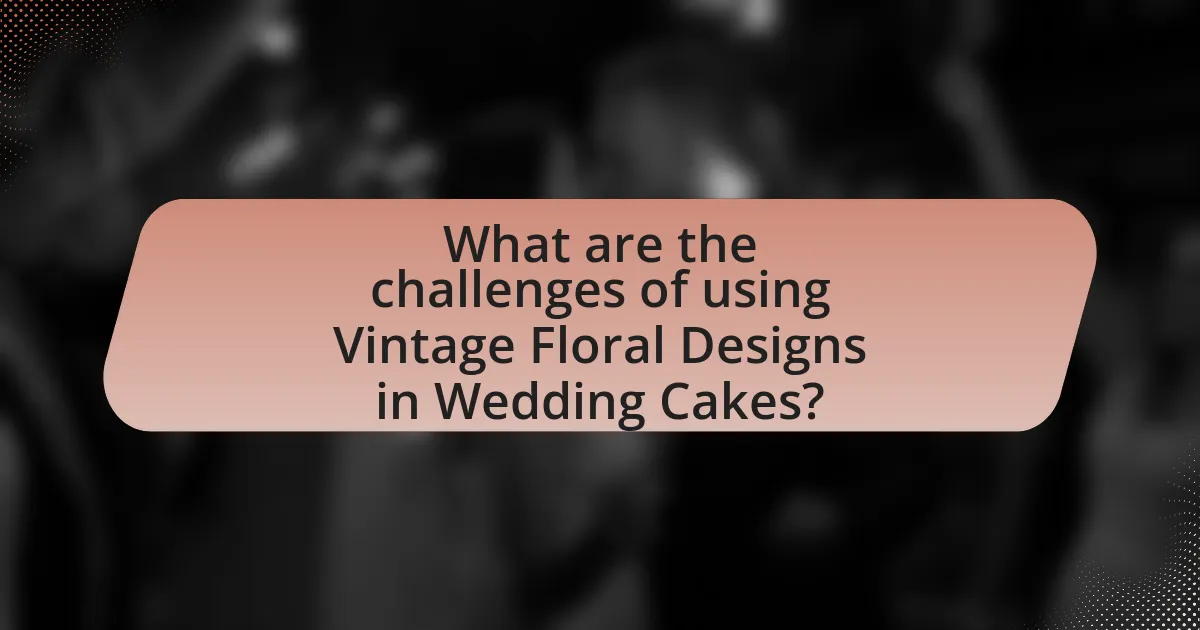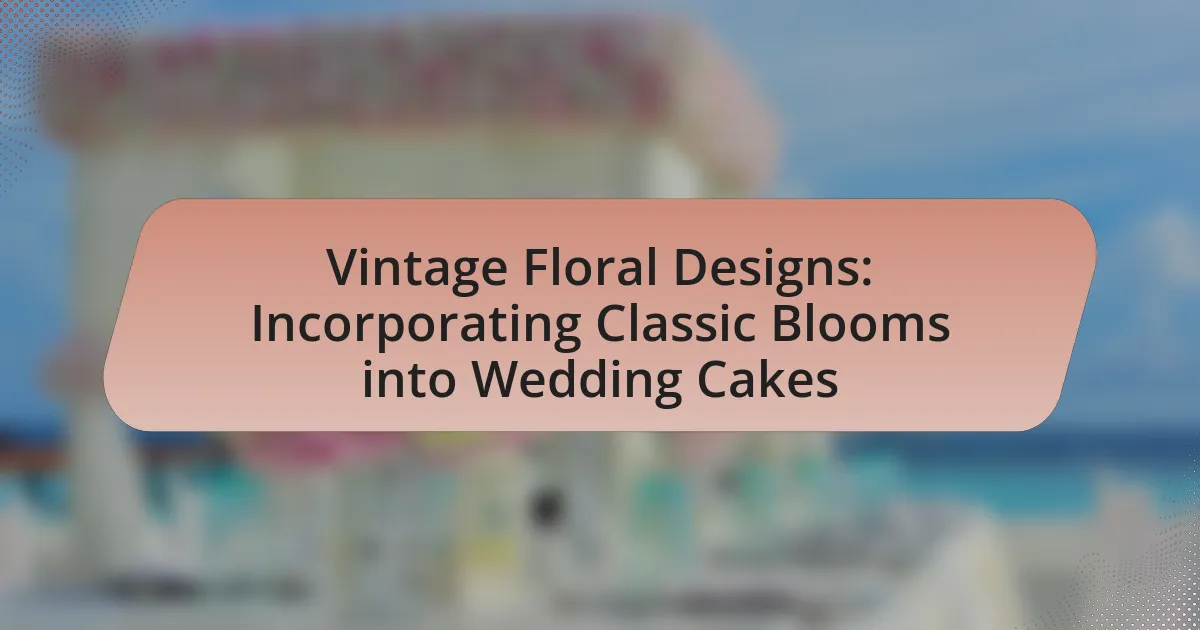Vintage floral designs in wedding cakes feature classic flower motifs inspired by historical styles, emphasizing intricate sugar flowers and hand-painted patterns that evoke nostalgia and elegance. This article explores the differences between vintage and modern cake designs, the historical influences shaping these floral aesthetics, and the significance of color palettes and classic blooms in enhancing the overall appeal of wedding cakes. It also discusses techniques for incorporating vintage floral designs, the challenges of using fresh flowers, and best practices for ensuring successful floral arrangements. Additionally, the article highlights current trends and emerging styles in vintage floral designs, providing insights into how cultural influences and seasonal flowers play a role in these timeless cake decorations.

What are Vintage Floral Designs in Wedding Cakes?
Vintage floral designs in wedding cakes are decorative elements that feature classic flower motifs, often inspired by historical styles and romantic aesthetics. These designs typically incorporate intricate sugar flowers, edible blooms, or hand-painted floral patterns that evoke a sense of nostalgia and elegance. The use of vintage floral designs can be traced back to traditional cake decorating practices, where flowers symbolized beauty and celebration, making them a popular choice for weddings. Such designs often reflect specific eras, like the Victorian or Art Nouveau periods, characterized by their detailed craftsmanship and soft color palettes, enhancing the overall romantic theme of the wedding.
How do Vintage Floral Designs differ from modern cake designs?
Vintage floral designs differ from modern cake designs primarily in their aesthetic and stylistic elements. Vintage floral designs often feature intricate, hand-painted flowers, soft color palettes, and a romantic, nostalgic feel, reflecting styles from the Victorian era or earlier. In contrast, modern cake designs tend to emphasize minimalism, bold colors, and geometric shapes, focusing on clean lines and contemporary trends. For instance, vintage designs may incorporate detailed sugar flowers and lace patterns, while modern designs might utilize fondant smooth finishes and abstract decorations. This distinction highlights the evolution of cake artistry, where vintage styles celebrate tradition and craftsmanship, whereas modern styles prioritize innovation and simplicity.
What historical influences shape Vintage Floral Designs?
Vintage floral designs are shaped by historical influences such as the Victorian era’s emphasis on intricate patterns and symbolism in floral arrangements. During the Victorian period, which spanned from 1837 to 1901, flowers were often used to convey specific meanings, leading to a rich vocabulary of blooms that influenced design aesthetics. Additionally, the Art Nouveau movement of the late 19th and early 20th centuries introduced organic forms and flowing lines, further impacting floral design by emphasizing natural beauty and elegance. These historical contexts have established a foundation for contemporary vintage floral designs, which often incorporate classic blooms like roses and peonies, reflecting the romantic and ornate styles of the past.
How do color palettes play a role in Vintage Floral Designs?
Color palettes are essential in Vintage Floral Designs as they evoke nostalgia and enhance the aesthetic appeal of the arrangements. Vintage floral designs typically utilize muted, soft colors such as pastels and earth tones, which reflect historical trends and create a romantic atmosphere. For instance, shades like dusty rose, sage green, and cream are commonly used to mimic the natural hues found in vintage gardens. This color selection not only aligns with the overall theme of vintage aesthetics but also influences the emotional response of viewers, making the designs feel timeless and inviting.
Why are Classic Blooms popular in Wedding Cakes?
Classic Blooms are popular in wedding cakes because they evoke a sense of timeless elegance and romance. Their traditional aesthetic aligns well with the vintage floral designs that many couples desire for their weddings. Classic Blooms, such as roses, peonies, and hydrangeas, are often chosen for their beauty and symbolism; for instance, roses represent love and passion, while peonies symbolize good fortune and prosperity. This popularity is further supported by trends in wedding planning that emphasize personalization and nostalgia, making these flowers a favored choice for couples looking to create a memorable and visually appealing cake that reflects their style and sentiments.
What types of Classic Blooms are commonly used?
Classic blooms commonly used in vintage floral designs for wedding cakes include roses, peonies, and hydrangeas. Roses are favored for their timeless elegance and variety of colors, peonies are appreciated for their lush, full appearance, and hydrangeas are chosen for their voluminous clusters that add texture. These flowers not only enhance the aesthetic appeal of wedding cakes but also symbolize love and romance, making them ideal for such occasions.
How do Classic Blooms enhance the aesthetic of wedding cakes?
Classic Blooms enhance the aesthetic of wedding cakes by adding elegance and a timeless quality to the design. These flowers, such as roses, peonies, and hydrangeas, are often chosen for their rich colors and intricate shapes, which create a visually appealing contrast against the cake’s surface. The use of Classic Blooms can evoke a sense of romance and sophistication, aligning with traditional wedding themes. Additionally, their natural beauty can complement various cake styles, from simple to elaborate, making them versatile in enhancing overall visual impact.
What techniques are used to incorporate Vintage Floral Designs into Wedding Cakes?
Techniques used to incorporate Vintage Floral Designs into Wedding Cakes include hand-painting, sugar flowers, and edible prints. Hand-painting allows for intricate floral patterns that mimic vintage styles, often inspired by classic botanical illustrations. Sugar flowers are crafted from fondant or gum paste, enabling realistic representations of vintage blooms, such as roses and peonies, which were popular in historical wedding aesthetics. Edible prints utilize food-safe ink to reproduce vintage floral designs directly onto the cake surface, providing a seamless and detailed appearance. These methods effectively capture the essence of vintage floral designs, enhancing the overall aesthetic of wedding cakes.
How can sugar flowers replicate real Vintage Floral Designs?
Sugar flowers can replicate real Vintage Floral Designs by utilizing precise techniques in shaping, coloring, and detailing that mimic the characteristics of authentic blooms. Artisans often study historical floral arrangements to capture the essence of vintage aesthetics, focusing on elements such as petal structure, color gradients, and texture. For instance, using edible dusts and airbrushing techniques allows for realistic shading that reflects the natural aging of flowers, which is a hallmark of vintage designs. Additionally, the use of specific flower types, like peonies and roses, which were popular in vintage arrangements, further enhances authenticity. This meticulous attention to detail ensures that sugar flowers not only resemble but also evoke the charm of real vintage floral designs.
What are the best practices for arranging flowers on wedding cakes?
The best practices for arranging flowers on wedding cakes include selecting edible flowers, ensuring proper placement for stability, and considering color harmony with the cake design. Edible flowers, such as pansies and violets, enhance both aesthetics and safety. Proper placement involves securing flowers in a way that prevents them from toppling or damaging the cake, often using floral tape or picks. Additionally, color harmony ensures that the flowers complement the cake’s overall theme, creating a cohesive look. These practices are supported by industry standards in cake design, emphasizing both visual appeal and food safety.
How can one choose the right Vintage Floral Design for a wedding cake?
To choose the right Vintage Floral Design for a wedding cake, one should consider the overall wedding theme, color palette, and flower types that resonate with vintage aesthetics. Selecting flowers such as peonies, roses, or hydrangeas, which are commonly associated with vintage styles, can enhance the design. Additionally, coordinating the floral design with the cake’s shape and texture, such as using delicate sugar flowers or fresh blooms, ensures a cohesive look. Research indicates that vintage floral designs often incorporate soft pastel colors and intricate detailing, which can be found in historical wedding cake trends from the early 20th century.
What are the key considerations when selecting Classic Blooms?
When selecting Classic Blooms for vintage floral designs in wedding cakes, key considerations include flower type, color palette, and seasonal availability. Flower type is crucial as certain blooms, like peonies and roses, evoke a classic aesthetic that complements vintage themes. The color palette should align with the overall wedding theme, ensuring that the blooms enhance the cake’s visual appeal. Seasonal availability is also important; using flowers that are in season guarantees freshness and longevity, which is essential for cake decoration. These factors collectively ensure that the selected blooms not only fit the vintage design but also maintain quality and aesthetic harmony.

What are the trends in Vintage Floral Designs for Wedding Cakes?
Current trends in vintage floral designs for wedding cakes emphasize the use of soft pastel colors, intricate sugar flowers, and a mix of classic blooms like peonies, roses, and hydrangeas. These designs often feature a combination of hand-painted floral patterns and three-dimensional floral elements, creating a romantic and timeless aesthetic. Additionally, the incorporation of natural textures, such as ruffles and lace, enhances the vintage appeal, while the use of metallic accents adds a modern twist. This trend reflects a growing preference for personalized and artisanal cake designs that evoke nostalgia and elegance.
How have Vintage Floral Designs evolved in recent years?
Vintage floral designs have evolved in recent years by integrating modern aesthetics with traditional motifs, resulting in a fresh interpretation of classic blooms. This evolution is characterized by the use of bolder color palettes, innovative textures, and a mix of vintage and contemporary elements, which cater to diverse wedding themes. For instance, the trend of incorporating dried flowers alongside fresh blooms has gained popularity, reflecting a shift towards sustainability and unique personalization in wedding cakes. Additionally, the rise of social media platforms has influenced design choices, as couples seek visually striking arrangements that stand out in photographs, further driving the evolution of vintage floral designs in the wedding industry.
What are the emerging styles in Vintage Floral Wedding Cakes?
Emerging styles in Vintage Floral Wedding Cakes include the use of muted color palettes, intricate sugar flower designs, and a combination of modern and traditional elements. These styles reflect a trend towards soft, romantic aesthetics that incorporate classic blooms like peonies and roses, often arranged asymmetrically for a more organic look. Additionally, the incorporation of textured finishes, such as ruffles or lace, enhances the vintage appeal while maintaining a contemporary twist. This evolution in design is supported by the growing popularity of personalized wedding themes that emphasize individuality and nostalgia.
How do cultural influences affect Vintage Floral trends?
Cultural influences significantly shape Vintage Floral trends by dictating the types of flowers, color palettes, and design aesthetics that are favored in various regions. For instance, in Victorian-era England, floral arrangements often featured roses and peonies, reflecting the era’s romantic ideals, while Japanese Ikebana emphasizes simplicity and balance, influencing floral design trends in contemporary settings. Additionally, cultural events and traditions, such as weddings and festivals, often dictate specific floral choices, as seen in the use of marigolds in Indian weddings, which symbolize prosperity and joy. This interplay between culture and floral design not only preserves historical significance but also adapts to modern interpretations, ensuring that Vintage Floral trends remain relevant and diverse across different cultural contexts.
What role do seasonal flowers play in Vintage Floral Designs?
Seasonal flowers are essential in Vintage Floral Designs as they enhance authenticity and aesthetic appeal. Utilizing flowers that bloom during specific seasons allows designers to create arrangements that reflect the natural beauty and color palette of the time, which is a hallmark of vintage style. For instance, peonies in spring or dahlias in late summer evoke a nostalgic feel, aligning with the historical context of vintage aesthetics. This approach not only ensures freshness but also connects the design to the cyclical nature of life and tradition, reinforcing the vintage theme in wedding cakes and floral arrangements.
Which flowers are best suited for each season?
Spring flowers best suited for the season include tulips, daffodils, and hyacinths. These flowers thrive in the cooler temperatures and are often among the first to bloom, symbolizing renewal. Summer flowers such as sunflowers, peonies, and roses flourish in warm weather, providing vibrant colors and fragrances ideal for weddings. In autumn, chrysanthemums, asters, and dahlias are prominent, as they adapt well to the cooler temperatures and offer rich, warm hues. Winter flowers like poinsettias, amaryllis, and hellebores are suited for the cold season, bringing festive colors and elegance to winter weddings. Each flower’s seasonal suitability is determined by its growth cycle and environmental preferences, ensuring they bloom at the right time for optimal use in floral designs.
How can seasonal flowers enhance the overall theme of a wedding cake?
Seasonal flowers can enhance the overall theme of a wedding cake by providing a fresh and cohesive aesthetic that aligns with the wedding’s seasonal setting. For instance, using spring blooms like peonies or tulips can evoke a sense of renewal and vibrancy, while autumn flowers such as chrysanthemums or dahlias can add warmth and richness to the cake’s design. This alignment not only complements the color palette of the wedding but also reinforces the overall floral theme, creating a harmonious visual experience. Additionally, seasonal flowers are often more readily available and cost-effective, ensuring that the cake design remains both beautiful and practical.

What are the challenges of using Vintage Floral Designs in Wedding Cakes?
The challenges of using vintage floral designs in wedding cakes include maintaining the aesthetic appeal while ensuring structural integrity and freshness of the flowers. Vintage floral designs often require intricate detailing and specific flower types that may not be readily available or may wilt quickly, compromising the cake’s appearance. Additionally, the use of real flowers necessitates careful consideration of food safety, as some flowers can be toxic if ingested. The complexity of arranging these designs can also lead to increased labor costs and time constraints for bakers, making it essential to balance artistic vision with practical execution.
What common issues arise when incorporating Classic Blooms?
Common issues that arise when incorporating Classic Blooms into wedding cakes include wilting, color fading, and potential toxicity. Wilting occurs due to the lack of water and nutrients, which can compromise the aesthetic appeal of the cake. Color fading happens when flowers are exposed to light and heat, diminishing their vibrant appearance. Additionally, certain flowers may contain toxic compounds that can pose health risks if ingested, necessitating careful selection of blooms. These challenges highlight the importance of understanding floral properties and their impact on cake design.
How can one prevent wilting or damage to fresh flowers on cakes?
To prevent wilting or damage to fresh flowers on cakes, one should use floral picks or water tubes to keep the stems hydrated. This method allows the flowers to absorb water, maintaining their freshness and appearance. Additionally, placing the flowers on the cake just before serving minimizes exposure to moisture and heat, which can accelerate wilting. Research indicates that flowers can remain vibrant for several hours when properly hydrated, thus enhancing the cake’s aesthetic appeal without compromising the flowers’ integrity.
What are the best methods for preserving the integrity of floral designs?
The best methods for preserving the integrity of floral designs include using floral preservatives, maintaining proper hydration, and selecting the right blooms. Floral preservatives contain nutrients and antimicrobial agents that extend the life of flowers, ensuring they remain vibrant and fresh. Proper hydration involves placing flowers in clean water immediately after cutting and regularly changing the water to prevent bacterial growth. Additionally, selecting blooms that are naturally resilient, such as roses and chrysanthemums, can enhance the longevity of floral arrangements. These methods are supported by studies indicating that flowers treated with preservatives can last up to 60% longer than those without, demonstrating their effectiveness in maintaining floral integrity.
What tips can help ensure successful Vintage Floral Designs in Wedding Cakes?
To ensure successful vintage floral designs in wedding cakes, focus on selecting authentic vintage flowers and colors that reflect the era you wish to emulate. Using flowers such as peonies, roses, and hydrangeas, which were popular in vintage arrangements, can enhance the design’s authenticity. Additionally, incorporating soft, muted color palettes like pastels or earth tones aligns with vintage aesthetics. Utilizing edible flowers or high-quality sugar flowers can also maintain the cake’s elegance while ensuring safety for consumption. Research indicates that vintage floral designs often evoke nostalgia, making them a popular choice for weddings, as they resonate emotionally with couples and their guests.
How can one effectively communicate floral preferences to a cake designer?
To effectively communicate floral preferences to a cake designer, one should provide specific details about the types of flowers desired, including color, size, and arrangement style. This clarity helps the designer understand the vision and ensures the cake aligns with the overall aesthetic. For instance, referencing particular flowers like peonies or roses, along with color palettes such as pastel or vibrant hues, allows for precise execution. Additionally, sharing images of desired floral arrangements can visually convey preferences, enhancing the designer’s understanding. This method is supported by industry practices where visual aids and detailed descriptions lead to higher satisfaction in custom cake designs.
What are the best practices for coordinating flowers with cake flavors and styles?
The best practices for coordinating flowers with cake flavors and styles involve selecting floral varieties that complement the cake’s taste profile and aesthetic. For instance, citrus-flavored cakes pair well with bright, zesty flowers like marigolds or orange blossoms, while rich chocolate cakes are enhanced by deep-colored blooms such as dark red roses or dahlias. Additionally, the style of the cake—whether it is rustic, elegant, or modern—should guide the choice of flowers; for example, wildflowers suit a rustic cake, while structured arrangements of peonies or orchids fit an elegant design. This approach ensures a harmonious balance between the visual and gustatory elements of the wedding cake, creating a cohesive and appealing presentation.
